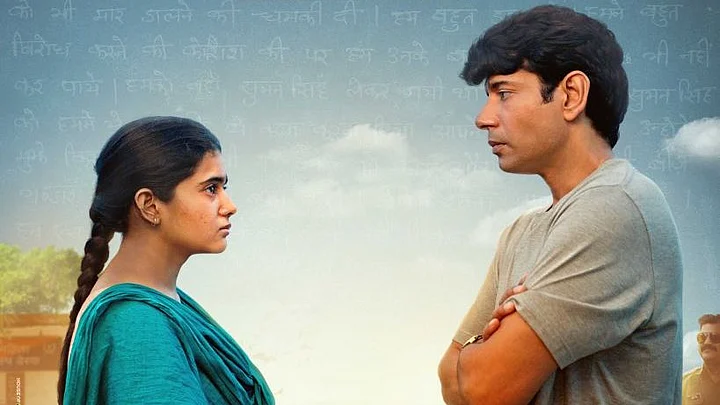What to expect when you have just been raped?
Trauma—physiological and psychological? Solidarity? Abandonment? Hopelessness? Healing? Institutional apathy? Societal neglect? Unexpected support? Violence? Another rape? Murder?
Manish Mundra's directorial debut Siya, releasing on 16 September, has questions popping out of each frame. Uncomfortable, utterly predictable questions. Siya is a film about rape that doesn't show or even name the act but conveys all that is attached to it: pain, indignation, injury, trauma, fear, dissociation, shame hopelessness.
Mundra's production house, Drishyam, has given gems like Masaan, Newton, Aankhon Dekhi, Ramprasad Ki Tehrvi et al in the past and with this latest tour de force it has established itself as a giant of filmmaking.
What is Rape, After All?
American psychiatrist, researcher, teacher, and author Judith Lewis Herman says, “... in practice the standard for what constitutes rape is set not at the level of women's experience of violation but just above the level of coercion acceptable to men.” The film throws open a challenge about determining the original point of violation. When is Siya violated first? Is it when she's raped the first time? Or, is it when she is accosted by the village goons on the road for the first time?
And then there is another list of nagging questions in one's head. Is rape enough to break one's spirit? Or does the rapist need something beyond the penetrative violation to do so? Is rape an accident or fait accompli? Why is rape meant to be the biggest tragedy of a woman's life? Can she ever be anything but a rape victim who has survived?
In her bestselling book, What We Talk About When We Talk About Rape author activist Sohaila Abdulali has made an effort to transform discourse around rape culture. It begins by putting our assumptions to test. The primary premise is, why does rape become the focal point of a victim's life—and that of her family—while the perpetrators move on even after being convicted. Mundra's film, in a subtle, unassuming way, is trying to do the same.
It might not have been the original directorial intent but the way Siya, a minor, carries on forces one to revisit attitudes towards the act of rape and its impact on the victim. After all, as Roland Barthes suggests, to impose an author on a text limits its meaning—Siya goes beyond directorial intent.
Why Rape Affects Us So Much?
Now, what is it about rape that affects us so? "Rape can be deeply traumatising as it vitiates what can be one of the most beautiful and satisfying physical act," says a woman politician who attended one of the pre-release shows.
But so can be an accident suffered during a favourite activity. Like, losing a limb in a car crash on one's favourite road. Or, getting one's skull open during a dive into the pool. How does one build a hierarchy of trauma?
And what about survival after the trauma?
The film is fast paced in its narration of Siya's travails after she's been raped. Mundra has been careful in steering clear of any sensationalism around it. Yet, the audience response is rather passionate. From advocating capital punishment for rapists of all stripes to on-the-spot formulations of schemes to help rape survivors and their families, all sorts of responses have poured in from different parts of the country. It is easy to surmise that Mundra has been able to touch a raw nerve with his debut.
The pre-release audience reactions have been encouraging for the film's team. Deploying a unique marketing strategy of taking the film to the masses even before the release, Mundra has been able to create a buzz around Siya. During the Delhi premiere—attended by more regular people than the who's who of the city—there were tears, sighs, words of solidarity, some promises, and a bunch of accolades for the team.
The Art of Siya
Mundra's production house is known for working with strong actors minus stardom. In Siya, he's gone a step forward by introducing a fresh face, Pooja Pandey, as the film's eponymous lead. The 26-year-old actor plays the role of 17 years old Siya with such conviction that it will be difficult for her to be seen as anyone else for some time.
Vineet Kumar of Mukkabaz and Gangs of Wasseypur fame has delivered a restrained and effective performance. The creative production by Rashmi Somvanshi and music by Neel Adhikari heightens the sense of despair and foreboding. Cinematography by Raffey Mahmood and Subhranshu Das is worth a special mention for how the camera captures both vulnerability and determination of the characters. Editing by Manendra Singh Lodhi is neat.
Siya mimics Greek tragedy in its the relentless buildup of tension without any relief. It might not go down well with filmgoers that seek escape in theatre. Many might accuse of Mundra having too cynical a worldview but the universe he creates in Siya has verisimilitude. From caste, class, to gender, the film exposes all forms of discriminations without any grandiloquence about changing the world.
As Brecht writes:
"In the dark times
Will there also be singing?
Yes, there will also be singing.
About the dark times.”
Verdict: ****/5
